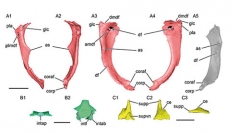

 Comptes Rendus Palevol
9 (6-7) - Pages 377-387
Comptes Rendus Palevol
9 (6-7) - Pages 377-387The latest works on iniopterygians question their monophyly when considering only the neurocranium of the two families (Sibyrhynchidae and Iniopterygidae), which have different conditions of preservation. Some of the synapomorphies of the Iniopterygia concern the pectoral girdle and fins. However, the anatomy of these different elements is still poorly known in this taxon. Here we describe in details three dimensionally preserved cartilages of the pectoral girdle and fins of the sibyrhynchid Iniopera sp. These structures have been extracted virtually from phosphatised nodules thanks to conventional and synchrotron microtomography, using absorption and phase contrast based techniques in the later case. The pectoral girdle of Iniopera sp. consists of three elements, which are, from dorsal to ventral, a paired suprascapular cartilage, a pair of robust scapulocoracoids and an unpaired intercoracoid cartilage. The scapular part of the scapulocoracoids is extremely reduced and the suprascapular cartilages link the scapulcoracoids to the rear of the neurocranium. These characters may be iniopterygian synapomorphies. Iniopterygians, stem and crown-holocephalans share a basipterygium that articulates with the pectoral girdle and bears an enlarged first pectoral fin radial. Posteriorly, the basipterygium articulates with either a well-defined metapterygium (in crown-holocephalans) or a metapterygial axis (in stem-holocephalans).
Chondrichthyes, Holocephali, Iniopterygia, Paleozoic, Pectoral girdle and fins, Phase imaging, Synchrotron, X-ray microtomography